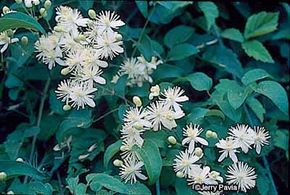In contrast to bush clematis, also called upright clematis, most gardeners think of clematis as vines that twine around a trellis or arbor, producing large flowers in great profusion. The plants described here are the shrub clematis, which are excellent for the bed or border. Clematis is a Greek word for "brush wood" and refers to the plant's branches.
: These are the tall shrubby plants with handsome, compound leaves and showy flowers are followed by silky seed heads. Ease of care: Easy.
Advertisement
Growing bush clematis, upright clematis: Plants like full sun to partial shade, requiring good, well-drained but moist soil with plenty of organic matter mixed in. The phrase "a cool root run" is often used to describe the wants of these plants, since clematis roots resent hot sun, dryness, and heat.
: By stem cuttings or by seed.
: Planted on a low bank, these plants can tumble down to the ground in a white cascade. They can also wander over low shrubs and small conifers. If neatness is desired, the plants can be ringed with a low wire fence, where the foliage will soon cover the support. The white, star-shaped flowers are fragrant and produce silky seed heads. A plant will grow in a large pot if kept out of the hot sun.
elated species: Clematis recta Purpurea has white flowers with rosy foliage. Clematis heracleifolia Davidiana bears lightly scented, blue flowers on bushy plants up to 4 feet high in the summer. Robert Brydon bears pale blue flowers and will grow to 10 feet. It can be tied to a trellis or allowed to fall over the other plants in the garden.
Scientific name for bush clematis, upright clematis: Clematis recta
Advertisement
